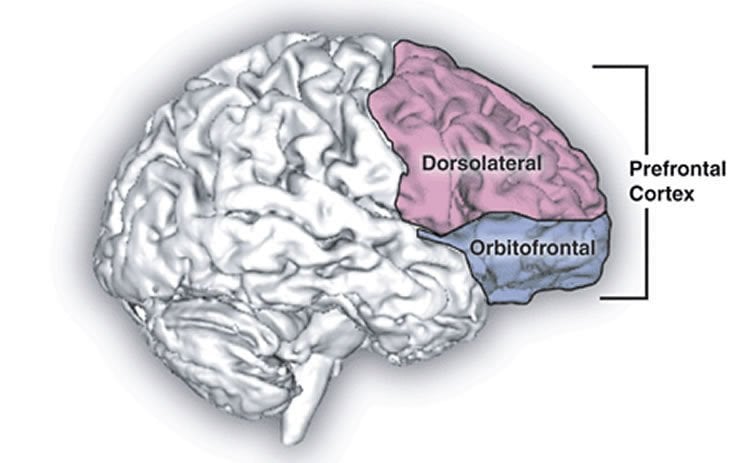Summary: A new study reveals the prefrontal cortex may play a role in coordinating the level of consciousness through the cholinergic system.
Source: University of Michigan.
Philosophers have pondered the nature of consciousness for thousands of years. In the 21st century, the debate over how the brain gives rise to our everyday experience continues to puzzle scientists. To help, researchers in the University of Michigan Medical School Center for Consciousness Science are working to identify areas of the brain that help us wake up, a basic building block of everyday consciousness.
In the search for what controls our overall level of consciousness, researchers have traditionally focused on structures in the lower part of the brain. These structures include the brainstem (which regulates vital functions like breathing, blood pressure and heartbeat); the hypothalamus (which is involved in sleep and controlling bodily functions); and the thalamus (which relays information from the senses). George Mashour, M.D., Ph.D., professor in the Department of Anesthesiology and director of the center, decided to look at different areas of the cortex, the upper part of the brain, for its ability to control the level of consciousness.
Recent research in nonhuman primates provides evidence that the prefrontal cortex has a switchboard-like relationship with other areas of the brain, helping to ignite awareness of visual information.
“There has been a debate that has recently intensified as to whether or not the prefrontal cortex — versus areas farther back — plays a role in generating conscious experience. We thought that we’d target some of these different areas in the front and back of the brain to see which ones had the ability to control the level of consciousness,” he says.
The key to ignition?
Because anesthesia is used to temporarily eliminate conscious experience during medical procedures, it provides the perfect opportunity to test hypotheses about consciousness.
Mashour and lead-author Dinesh Pal, Ph.D., also of the Department of Anesthesiology, anesthetized rats with a common anesthetic used in humans. “We wanted to see what had the causal power to take an unconscious brain receiving ongoing anesthesia and wake it up,” says Pal. To test this, they targeted two neurotransmitters that are associated with wakefulness: acetylcholine and norepinephrine.

The team exposed the anesthetized rats’ prefrontal and parietal cortex to drugs that ramped up the effect of the neurotransmitters and measured their brain activity and behavior. When exposed to an acetylcholine-receptor activator, their brain waves, normally slow during sleep and anesthesia, sped up. But rats were able to start behaving as though they were awake only with prefrontal cortex stimulation, all while continuing to receive the same level of anesthesia that is used clinically for surgery in humans. These findings were published in the journal Current Biology.
Mashour says their new study “suggests that the prefrontal cortex also has the potential to play a role in coordinating the level of consciousness, possibly through the cholinergic system.”
Clinically, these results could be explored for applications in people with disorders of consciousness, such as coma or vegetative states. “Let’s say you have a patient in a coma: Could the prefrontal cortex be a site that is modulated to help coordinate events to help improve level of consciousness?” Mashour asks. The implications of this possibility are significant because of the relative accessibility of the prefrontal cortex.
“It’s very difficult and dangerous to directly intervene at the level of arousal centers in the brainstem because of its location, small size and nearby vital functions. Maybe the prefrontal cortex is an accessible gateway to some of those other arousal systems that could be leveraged in a clinical setting outside of anesthesia,” he says.
Funding: This work was funded by the National Institutes of Health (R01GM098578), and the Department of Anesthesiology, University of Michigan Medical School, Ann Arbor. Physiology doctoral student Jon Dean was co-first author of the article.
Source: Kelly Malcom – University of Michigan
Publisher: Organized by NeuroscienceNews.com.
Image Source: NeuroscienceNews.com image is in the public domain.
Original Research: Open access research for “Differential Role of Prefrontal and Parietal Cortices in Controlling Level of Consciousness” by Dinesh Pal, Jon G. Dean, Tiecheng Liu, Duan Li, Christopher J. Watson, Anthony G. Hudetz, and George A. Mashour in Current Biology. Published June 21 2018.
doi:10.1016/j.cub.2018.05.025
[cbtabs][cbtab title=”MLA”]University of Michigan “Waking Up is Hard to Do: Prefrontal Cortex Implicated in Consciousness.” NeuroscienceNews. NeuroscienceNews, 21 June 2018.
<https://neurosciencenews.com/pfc-consciousness-9406/>.[/cbtab][cbtab title=”APA”]University of Michigan (2018, June 21). Waking Up is Hard to Do: Prefrontal Cortex Implicated in Consciousness. NeuroscienceNews. Retrieved June 21, 2018 from https://neurosciencenews.com/pfc-consciousness-9406/[/cbtab][cbtab title=”Chicago”]University of Michigan “Waking Up is Hard to Do: Prefrontal Cortex Implicated in Consciousness.” https://neurosciencenews.com/pfc-consciousness-9406/ (accessed June 21, 2018).[/cbtab][/cbtabs]
Abstract
Differential Role of Prefrontal and Parietal Cortices in Controlling Level of Consciousnesss
Highlights
•Prefrontal cholinergic stimulation induces wake-like behavior in anesthetized rats
•Cholinergic stimulation of parietal regions did not induce behavioral transitions
•Prefrontal/parietal noradrenergic stimulation did not induce behavioral transitions
•Electroencephalographic activation and level of consciousness are dissociable
Summary
Consciousness is determined both by level (e.g., being awake versus being anesthetized) and content (i.e., the qualitative aspects of experience). Subcortical areas are known to play a causal role in regulating the level of consciousness, but the role of the cortex is less well understood. Clinical and correlative data have been used both to support and refute a role for prefrontal and posterior cortices in the level of consciousness. The prefrontal cortex has extensive reciprocal connections to wake-promoting centers in the brainstem and diencephalon, and hence is in a unique position to modulate level of consciousness. Furthermore, a recent study suggested that the prefrontal cortex might be important in regulating level of consciousness but causal evidence, and a comparison with more posterior cortical sites, is lacking. Therefore, to test the hypothesis that prefrontal cortex plays a role in regulating level of consciousness, we attempted to reverse sevoflurane anesthesia by cholinergic or noradrenergic stimulation of the prefrontal prelimbic cortex and two areas of parietal cortex in rat. General anesthesia was defined by loss of the righting reflex, a widely used surrogate measure in rodents. We demonstrate that cholinergic stimulation of prefrontal cortex, but not parietal cortex, restored wake-like behavior, despite continuous exposure to clinically relevant concentrations of sevoflurane anesthesia. Noradrenergic stimulation of the prefrontal and parietal areas resulted in electroencephalographic activation but failed to produce any signs of wake-like behavior. We conclude that cholinergic mechanisms in prefrontal cortex can regulate the level of consciousness.







